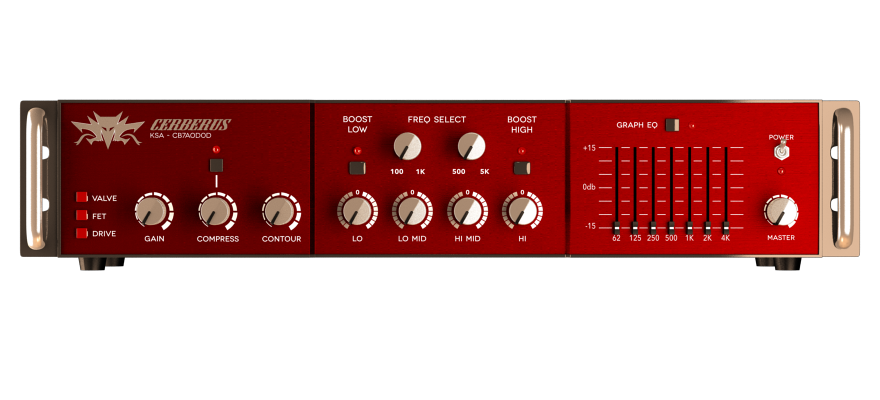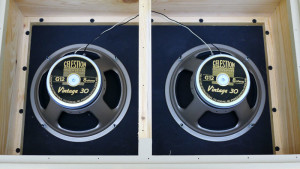The modeled, simulated behavior of the guitar amplifier softwares are basically mimicking every character, nuances, even including imperfections of their analog counterparts. Therefore, a “real world” knowledge are essential to operate guitar amp softwares faithfully for a flawless guitar recording.
Amplifiers

The modeled Cerberus’ Head Amp. Including 3 kind of amplifiers: FET / solid state, Tube, and Drive.
Along the advancement since it’s invention by the first half of the 20th century, guitar amplifiers have evolved in its prominence in shaping the sound of the 20th century’s music. From solely as a speaker for acoustic guitar, to adding extra amplification power to tone-shaping equaliziation, to a built in effect circuit such as tremolo and reverbs, to modeling multiple amplification characteristics within a single amplifier using microprocessors. Making guitar sounds getting louder, grittier, and richer, and divides music into great variations of genre depended on the sounds produced by guitars.
After the guitar itself, Amplifier is the second most important thing to determine how your tone would sound. There are typically two stages of amplification in a head amplifier: a preamplifier stage in the input gain, and power amplifier to drive the speakers (inside a cabinet). The amplifier itself are divided into two kinds which greatly affect the tone produced by the amps: Vacuum tubes which dominates before the 1970’s when semiconductors start replacing the tubes. Even though it’s an outdated technology, the tubes are still favorable by many guitarists due to it’s warm, classic characteristic. The other one is the solid-state / FET based on semiconductors; smaller, less heat, and inexpensive. A combination of tubes and solid-state are also available as a hybrid amplifier. Distinctively, there are also many jazz guitarists who prefers the sound of a solid-state amp due to it’s “cleaner” characteristics. Appearance wise, there are two kinds of guitar amplifiers: Head-Cabinet which larger in design and separated between head amp and cabinet. Usually carries larger, more speakers and driven with bigger power. In the other hand, a Combo amp are a single package of amp and speakers within a single unit, and usually driven by smaller power and lesser number of speakers for somewhat more portable use.
Cabinets

the speakers inside a 2×12 combo amp. source: http://www.gad.net/Blog/2011/07/29/1963-fender-bassman-face-lift/
Guitar cabinets usually contains one or more 10 or 12 inch speakers enclosed within a wood case. As many as 8 or sometimes 10 can be enclosed within a single cabinets. Commonly, the naming of 4×12 or 8×10 cabinets describe the amount and the size of speakers inside the cabinets; for example, a 4×12 means that there are four 12-inch speakers inside the cabinets, while 8×10 means that there are eight 10-inch speakers inside the cabinet.
Since it’s the place where the sound of the guitar was produced, it’s one of the crucial component when it comes to the guitar recording. The guitar speaker itself usually a specialty speaker where the frequency produced are tailored to response within the relevant frequency range of the guitar sound itself.
Microphones
To record guitars, microphones are the next essential components to capture the tone produced by the guitar-amp-cabinet combination. So, the correct setup and type of microphones that we choose can either matched the tone that we desired, or either alter it. Typically, a microphone are an acoustic-to-electric sensor that converts captured acoustic signals into an electric signal. Let’s discuss all kind of microphones that is included within our Kuassa Amplifikation series: Dynamic, Condenser, and Ribbon.

A pair of SM57s is the weapon of choice for the US presidents since the early 1960s. Source: Video Journalist Today
A dynamic microphone work via electromagnetic induction using a moving coil. The captured acoustic signals are vibrating the moving coil are attached to a diaphragm to be transformed into electricity. For guitar amplifier miking, this kind is the go-to method used along with an on-axis placement near the amplifier’s cabinet grill to get the straight up, fat tone. Most of the dynamic microphones have a rich midrange which can respond well to most guitar sounds.
Condenser microphones are come in both solid-state and tube variations. Known for it’s speedy responsiveness and ability to capture broader frequency range due to it’s more high-frequency sensitive diaphragm rather that a moving coil. Due to it’s high frequency sensitivity, it’s works best to capture the richness of small nuances and airiness of the guitar sounds while the drawbacks are it’s absolute need of external power from battery or phantom power.
A comeback from the old-radio era, Ribbon Microphones are using a thin piece of metal ribbon as a diaphragm for capturing movement of air rather than sound pressure level (SPL). It’s known for it’s silky highs and unique low-mid response resulting a rich and warm sound for capturing better punch and warm sound of the amplifier. The drawbacks is the delicate ribbon’s sensitivity to rip or tear, but today’s modern technology are improving the ribbon mics to be more robust to be used inside daily studio use.

